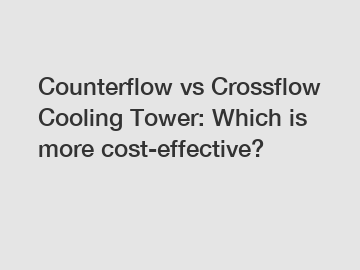**Counterflow vs Crossflow Cooling Tower: Which is more cost-effective?**.
1. **What is a counterflow cooling tower?**.
A counterflow cooling tower is a type of cooling tower where the air flow direction is opposite to the flow of water. In this design, hot water enters the cooling tower from the top and flows downward while the air is forced upward through the tower, allowing for effective heat exchange.

2. **What is a crossflow cooling tower?**.
A crossflow cooling tower is another type of cooling tower where the air flow direction is perpendicular to the flow of water. In a crossflow design, water is distributed horizontally across the tower while air is drawn in through the sides, allowing for heat exchange across the flow.
3. **Which is more cost-effective?**.
In general, counterflow cooling towers are considered to be more cost-effective compared to crossflow cooling towers. This is mainly because counterflow towers have a more efficient heat transfer process due to the direct counterflow of air and water streams. As a result, counterflow cooling towers require less energy to operate and can achieve a higher cooling efficiency.
4. **Why are counterflow cooling towers more cost-effective?**.
Counterflow cooling towers have a longer contact time between the air and water streams, leading to better heat transfer efficiency. Additionally, counterflow towers typically have a smaller footprint compared to crossflow towers, making them more space-efficient and cost-effective in terms of installation and maintenance.
5. **Are there any drawbacks to counterflow cooling towers?**.
While counterflow cooling towers are generally more cost-effective, they may have higher initial costs compared to crossflow towers. This is because counterflow towers are more complex in design and require precise engineering to achieve optimal performance. However, the long-term cost savings from lower energy consumption and maintenance expenses often outweigh the initial investment.
6. **Conclusion**.
In conclusion, when considering the cost-effectiveness of cooling towers, counterflow cooling towers are generally preferred due to their higher efficiency and lower energy consumption. While they may have higher initial costs, the long-term savings make them a more cost-effective option for industrial cooling applications.
If you want to learn more, please visit our website bac closed circuit cooling tower, cooling tower gear reducer, what is dry cooling.
Previous
None
Comments
Please Join Us to post.
0